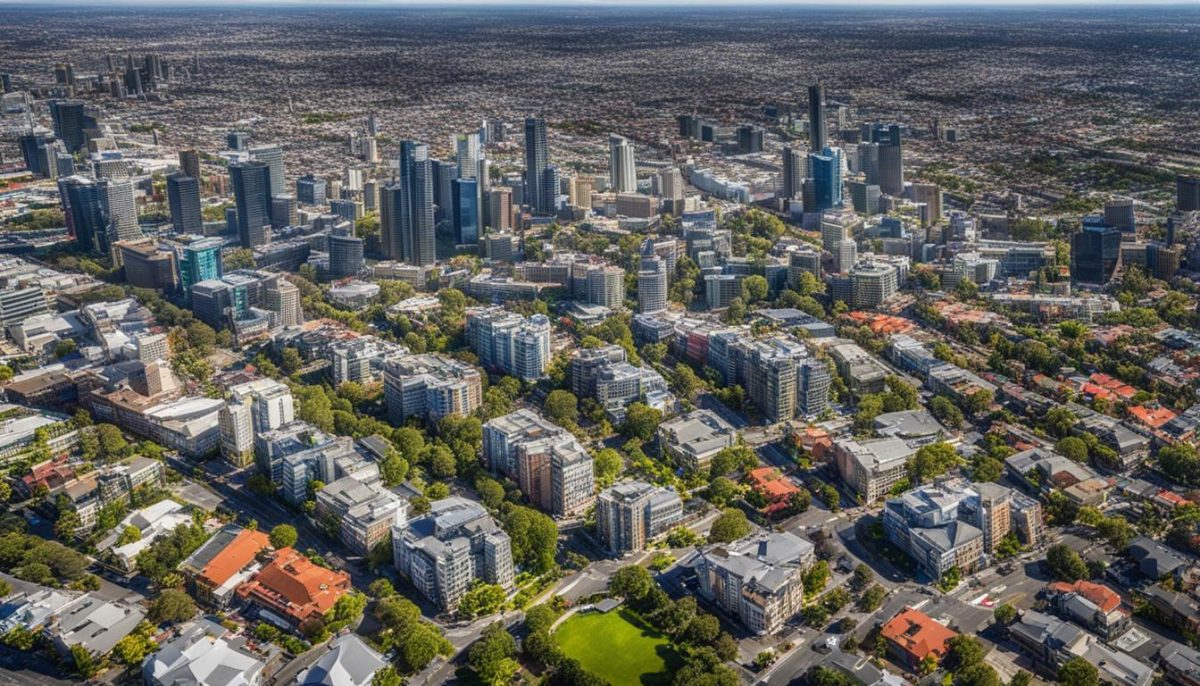News
Melbourne Real Estate in 2024
Welcome to our comprehensive market analysis of Melbourne real estate in 2024. In this article, we will explore the current trends, provide expert insights, and offer valuable tips to navigate the dynamic Melbourne property market. Whether you are a buyer, seller, or investor, understanding the intricacies of the Melbourne real estate landscape is essential for making informed decisions. Let’s dive in and explore the exciting opportunities and challenges that await in the Melbourne property market.
Key Takeaways
- Melbourne’s real estate market is projected to experience moderate growth in 2024.
- Experts predict a rise in both house and unit values, albeit at a slower pace compared to previous years.
- Several suburbs, including Westmeadows, Epping, and Windsor, present growth opportunities for buyers.
- Interest rates and affordability play a significant role in the market, influencing buyer behavior and demand.
- Population growth, urban planning reforms, and housing supply are essential factors shaping the Melbourne property market.
Suburbs Set to Grow in 2024
As the Melbourne real estate market continues to evolve, experts have identified several suburbs that show promising potential for growth in 2024. These suburbs offer a range of advantages, including affordability, desirable amenities, and proximity to the CBD. Whether you are a homebuyer or an investor, exploring these suburbs could lead you to profitable opportunities.
Here are some Melbourne suburbs set to experience growth in 2024:
- Westmeadows: Located 16 kilometers northwest of the CBD, Westmeadows provides a unique “living in the country” feel while being close to the bustling city. The median house price in Westmeadows is $700,000, while units have a median price of $529,250.
- Epping: Situated further north, Epping is known for its natural beauty and affordability. It has been named Melbourne’s most affordable and liveable suburb. The median house prices in Epping are $666,000, and units have a median price of $425,000.
- Inner City Suburbs: Suburbs like Windsor, Prahran, Richmond, Fitzroy, St Kilda, and Port Melbourne offer excellent investment opportunities. Victorian-type cottages with two bedrooms, priced around $1 million to $1.5 million, are particularly attractive options in these vibrant inner-city areas.
- Fawkner: Located 12 kilometers from the CBD, Fawkner presents a family-friendly lifestyle at an affordable price. The median house prices in Fawkner are $758,500, and units have a median price of $525,000.
- Mornington Peninsula: Looking beyond the city, the Mornington Peninsula offers potential investment opportunities. Property prices have dropped, and there is a possibility of securing up to 30% discounts from peak prices witnessed in 2021-22.
- Development Sites: Development sites within 15 to 20 kilometers from the CBD, situated close to local amenities, also present exciting opportunities for investment. These sites offer unbroken ground for potential development and are priced competitively.
Explore the table below for a detailed comparison of the median prices in these suburbs:
| Suburb | Median House Price ($) | Median Unit Price ($) |
|---|---|---|
| Westmeadows | 700,000 | 529,250 |
| Epping | 666,000 | 425,000 |
| Fawkner | 758,500 | 525,000 |
Investing in these growing suburbs can provide opportunities for long-term capital growth and rental returns. Conduct thorough research and consider the potential of each area before making any investment decisions.
With its diverse range of suburbs and a market primed for growth in 2024, Melbourne presents an enticing real estate landscape for homebuyers and investors alike.
Property Market Predictions for 2024
In 2024, the property market in Melbourne is expected to see a continuation of price growth, although at a slower pace than previous years. According to Domain’s 2024 Outlook Report, house and unit prices are projected to increase, but factors such as affordability and borrowing power may hinder buyers’ ability to enter the market.
A potential cut in interest rates or an easing of the mortgage serviceability buffer could provide some relief for buyers, improving their outlook. The flight to affordability may also lead buyers to explore secondary suburbs, where property prices may not be as high.
Furthermore, progressive housing and national planning reforms are anticipated in 2024. There will be a focus on both urban sprawl and densification, with a need to strike a balance between the two. The goal is to provide housing options that cater to the growing population demand, while also considering sustainable urban development.
Speaking of population growth, it is expected to continue driving housing demand in Melbourne. The city’s popularity and economic opportunities attract people from all over Australia, leading to a need for more housing options.
However, it is important to note that these property market predictions are based on certain contingencies, such as the rate of migration and inflation. Changes in these factors can significantly impact the market dynamics and outcomes.
“While property prices are expected to increase, factors such as affordability and borrowing power may limit buyers’ ability to purchase homes.”

National Housing Market Forecast
SQM Research’s Housing Boom and Bust Report 2024 provides valuable insights into the forecast for the national housing market in 2024. Our comprehensive analysis predicts a modest to moderate correction in home prices across major cities, including Sydney, Melbourne, Canberra, and Hobart.
This correction is expected to be influenced by affordability issues and higher interest rates, which may pose challenges for potential buyers. However, it’s important to note that not all cities will experience the same downturn. Perth and Brisbane, for example, are anticipated to record price rises due to a recovering Chinese economy and strong demand for base commodities.
In contrast, Canberra is expected to experience the largest price falls, while Adelaide and Darwin are likely to remain steady or see minor rises/corrections. These forecasts are based on assumptions regarding migration rates and inflation, which can significantly impact the housing market.
“The national housing market is resilient, and despite some expected corrections, it continues to present opportunities for buyers and investors.”
It’s important to take note of distressed selling activity, which is expected to increase in the coming year. This may add some pressure to the market, particularly in terms of supply and demand dynamics. Additionally, the rental markets are projected to experience sustained growth, with Perth emerging as a standout performer.
To provide a visual representation of the national housing market forecast, we have prepared the following table:
The above table highlights the forecasted changes in home prices across different cities. It illustrates the potential for both corrections and growth, giving investors and buyers a better understanding of the market landscape.
Despite the challenges, the national housing market remains dynamic and resilient. Each city presents its own unique opportunities, and careful consideration of the forecasted trends can help buyers and investors make informed decisions.
Impact of Interest Rates and Affordability
Interest rates and affordability are crucial factors that influence the real estate market. An increase in interest rates coupled with affordability issues has limited buyers’ ability to purchase homes. However, there are potential solutions that could boost borrowing power and demand.
A potential cut in interest rates or an easing of the mortgage serviceability buffer would have a direct impact on affordability and borrowing capacity. Currently, the mortgage serviceability buffer is set at three percentage points, ensuring homeowners can afford mortgage repayments even if interest rates rise. However, by easing this buffer to 2.5 percentage points or lowering interest rates, buyers would gain more borrowing power and improve consumer sentiment.
With greater borrowing power, buyers may be able to explore more housing options and overcome affordability challenges. Considering secondary suburbs or taking advantage of government schemes, such as Help to Buy, can also help potential buyers find affordable housing solutions.
“A potential cut in interest rates or an easing of the mortgage serviceability buffer could give buyers greater borrowing power and improve consumer sentiment.” – Real Estate Expert
Benefits of a Potential Cut in Interest Rates
- Increased borrowing capacity for potential homebuyers
- Improved affordability and access to homeownership
- Positive impact on consumer sentiment and market confidence
- Potential boost to housing market activity
Government Schemes and Assistance Programs
In addition to a potential change in interest rates, government schemes and assistance programs can also help alleviate affordability concerns. Help to Buy, for example, assists first-time buyers by offering support with a deposit for a newly constructed home.
By combining potential interest rate cuts, easing of the mortgage serviceability buffer, and government assistance programs, aspiring homeowners can enhance their chances of entering the property market and achieving their homeownership goals.
| Benefits | Considerations |
|---|---|
|
|

Urban Planning and Housing Reforms
At Domain, we predict a significant shift in attitudes towards urban planning, as communities evolve from a “not in my backyard” (NIMBY) mindset to a more progressive “yes in my backyard” (YIMBY) approach. This changing perspective reflects the recognition of the need for both urban sprawl and densification in our cities. Urban densification involves increasing housing density on existing land, such as building multiple dwellings on a single block or terrace houses, to accommodate the growing population in a sustainable manner.
Local governments play a key role in determining the course of development, and there is now a push for national planning reforms. These reforms aim to address the ongoing shortage of new homes by balancing housing supply and demand, particularly in major cities like Sydney and Melbourne. By encouraging densification and providing more options for homebuyers, these reforms support the overall goal of enhancing housing affordability and accessibility.
“The push for urban planning reforms aims to address the ongoing shortage of new homes by balancing supply and demand.”
For instance, in Sydney, the Greater Sydney Commission has developed the Eastern City District Plan, which focuses on housing densification towards the city’s east, aiming to transform it into a vibrant urban corridor. The plan encourages the development of high-density residential areas and mixed-use precincts, creating a balance between housing, jobs, and amenities.
In Melbourne, strategic planning schemes such as Plan Melbourne 2017-2050 have been formulated to guide the city’s growth. These plans emphasize the importance of urban densification in designated areas through the development of higher-density housing options and better connectivity to transportation networks.
Promoting Sustainable Communities
Urban planning and housing reforms not only address the housing supply shortage but also contribute to the creation of sustainable and liveable communities. By integrating housing, public transport, and essential amenities in close proximity, these reforms aim to reduce commuters’ reliance on private vehicles, decrease congestion, and enhance the overall quality of life.
Furthermore, densification allows for the efficient use of land and infrastructure, reducing the need for urban sprawl and preserving green spaces. By providing housing options closer to employment hubs, educational institutions, and recreational facilities, these reforms help create vibrant and inclusive communities that support residents’ daily needs.
The Impact on Housing Market Dynamics
Urban planning and housing reforms have a direct impact on the dynamics of the housing market. By increasing housing supply through densification, these reforms help alleviate price pressures and enhance housing affordability, particularly in high-demand areas. The availability of diverse housing options, including medium and high-density developments, townhouses, and apartments, provides homebuyers with a wider range of choices to suit their needs and budget.
Moreover, the implementation of these reforms stimulates construction and development activity, generating employment opportunities within the housing industry. The growth of the construction sector boosts job creation and contributes to economic growth.
Case Study: Melbourne’s Densification Initiatives
In Melbourne, there have been notable initiatives that demonstrate the success of urban planning and housing reforms in achieving densification. The Fishermans Bend Urban Renewal Area is one such project, encompassing large-scale urban development in the heart of Melbourne. This mixed-use precinct aims to transform the former industrial land into a vibrant community, providing housing, employment, and recreational opportunities.
The development of high-rise apartment buildings and mixed-use developments within Fishermans Bend showcases the successful implementation of densification principles. This transformation has contributed to increased housing supply and improved connectivity to the CBD, attracting both residents and businesses to the area.
| Densification Initiatives in Melbourne | Key Features |
|---|---|
| Fishermans Bend Urban Renewal Area | – Mixed-use precinct – High-rise apartment buildings – Improved connectivity to CBD |
| Coburg Plan | – Development of key precincts – Medium-density housing options – Enhanced public transport |
| Montague Precinct | – Mixed-use developments – Increased housing supply – Sustainable design principles |

These initiatives, along with others like the Coburg Plan and the Montague Precinct, demonstrate the success of urban planning and housing reforms in Melbourne. By embracing urban densification and encouraging the development of diverse housing options, Melbourne is addressing the increasing demand for housing while promoting sustainable community growth.
Population Growth and Housing Demand
Strong population growth continues to have a significant impact on the real estate market in Australia, including Melbourne. This growth is driven by various factors, including migration and overseas students seeking higher education opportunities. While net overseas migration is expected to peak in 2024, the overall population growth is projected to remain strong. This sustained population growth contributes to an increased demand for housing, both in terms of rental properties and home purchases.
The tight rental market, influenced by population growth and limited supply, has created challenges for renters in finding affordable accommodation. However, this situation has also led many Australians to consider buying property as a more appealing and viable option. As the demand for rental properties continues, policies supporting first-home buyers can play a crucial role in easing the demand in the rental market and encouraging tenants to transition into homeownership.
In the latter half of 2024, rental price growth is expected to slow down as the rental market approaches a tipping point. This slowdown can provide relief to tenants who have been facing rising rental costs. However, it is important to note that the rental market remains competitive, and finding affordable rental properties can still be challenging for some individuals and families.
Rental Market Outlook:
Despite the challenges posed by a tight rental market, there are opportunities for tenants to enter the property market and become homeowners. Policies supporting first-home buyers, such as government grants and incentives, can make homeownership more accessible and affordable. Additionally, the slowdown in rental price growth creates a window of opportunity for tenants to save and transition into property ownership.
| City | Rental Price Growth | Opportunities for Tenants |
|---|---|---|
| Sydney | 5% – 7% | Government grants and incentives |
| Melbourne | 3% – 5% | Slowing rental price growth |
| Brisbane | 3% – 6% | Affordable housing options |
As the real estate market evolves, it is crucial for tenants to explore their options, consider long-term financial goals, and seek professional advice when making decisions regarding homeownership. The transition from tenants to buyers requires careful financial planning and an understanding of the property market dynamics.
Investing in property can provide long-term financial stability and wealth accumulation, and the current market conditions present opportunities for renters to embark on the journey towards property ownership.
Rental Market Outlook
In 2024, the rental market in Australia is expected to face ongoing challenges. High demand and limited supply will contribute to rental price increases nationwide, with Perth projected to experience the largest surge of 12% to 15%. This tight rental market may pose difficulties for renters seeking affordable options.
However, there is potential relief on the horizon. As more policies are implemented to support first-home buyers, demand in the rental market is anticipated to ease, leading to a slowdown in rental price growth. This transition of tenants becoming buyers could impact the rental market further, creating opportunities for renters to enter the property market and potentially find more affordable rental options.
While the outlook remains challenging, it is important for renters to remain vigilant and explore all available avenues to secure suitable accommodation. In a competitive rental market, being well-prepared and responding quickly to rental opportunities can increase the chances of finding rental properties that meet their needs and budget.
Opportunities in Development Sites
Apart from houses and units, development sites present notable opportunities for astute buyers. The cost of construction has led to development sites being offered at competitive rates, particularly in suburbs within 15 to 20 kilometers from the CBD and close to local amenities. These sites offer unbroken ground for potential development and investment.
Areas with a price range of approximately $1.6 million to $1.8 million are considered the sweet spot for such investments. Buyers should consider the potential for future growth and demand when investing in development sites.
Factors Impacting Melbourne Property Prices
When it comes to property prices in Melbourne, several key factors come into play. Understanding these factors is essential for both buyers and sellers to make informed decisions in the real estate market. Let’s explore the main drivers that influence Melbourne property prices in 2024.
1. Interest Rates
Interest rates have a significant impact on property prices. Fluctuations in interest rates can directly influence the demand for properties. For example, rate cuts can stimulate demand, as lower interest rates make purchasing a property more affordable. On the other hand, rate hikes can dampen demand, as higher interest rates increase borrowing costs for potential buyers.
2. Affordability and Borrowing Power
Affordability issues and borrowing power play a crucial role in determining property prices. Affordability constraints can create a ceiling on buyers’ budgets, limiting their ability to enter the market or purchase properties at higher price points. Similarly, changes in borrowing capacity, influenced by factors such as lending criteria and loan-to-value ratios, can affect buyers’ purchasing power and, in turn, impact property prices.
3. Migration and Population Growth
Melbourne’s property market is influenced by migration rates and population growth. Higher migration rates contribute to increased housing demand, putting upward pressure on property prices. Population growth, driven by migration and natural population increase, influences both the demand for properties and the need for additional housing supply to accommodate the growing population.
4. Inflation
Inflation, as a macroeconomic factor, affects the overall economy and influences purchasing power. When inflation rises, the cost of goods and services increases, and the value of money decreases. As a result, property prices may adjust to account for the changing purchasing power of individuals and households.
5. Market Sentiment and Government Policies
Market sentiment, influenced by factors such as consumer confidence, economic indicators, and investor sentiment, can impact property prices. Positive market sentiment can drive demand and push prices higher, while negative sentiment can lead to decreased demand and price corrections. Additionally, government policies related to housing, taxation, and economic measures can affect property prices. Changes in regulatory frameworks, incentives, or taxation policies can influence buyer behavior and have an impact on property market dynamics.
By keeping a close eye on these key factors, buyers and sellers can better navigate the Melbourne property market and make well-informed decisions. It is important to note that property prices can be influenced by a combination of these factors, and their interactions may produce both short-term fluctuations and long-term trends. Understanding these dynamics can help stakeholders adapt to changing market conditions and seize opportunities in the Melbourne property market.
Property Market Resilience Amid Challenges
Despite the economic challenges faced by the Melbourne property market, it has exhibited remarkable resilience in recent years. The market experienced a significant recovery in 2023, and though growth may be slower in 2024, the overall stability remains intact. While certain areas may witness price corrections, the market continues to offer opportunities for both buyers and sellers.
The property market trends indicate a cautious yet optimistic outlook. Rising interest rates and affordability issues pose challenges, influencing buyer behavior and market dynamics. However, secondary suburbs, development sites, and investment properties present potential avenues for growth and profit.
“The Melbourne property market has shown remarkable resilience, with stability despite economic challenges.”
Market Trends and Insights
Amid economic challenges, market trends suggest a cautious approach in the property market. Buyers and sellers should consider the following:
- Stay updated with market trends and economic indicators to make informed decisions.
- Explore opportunities in secondary suburbs that show potential for growth.
- Investigate investment properties and development sites as key sources of profit and returns.
Opportunities in Property Investment
Despite the challenges, there are opportunities to be found in the Melbourne property market:
- Secondary suburbs offer affordability while still presenting potential for growth and capital appreciation.
- Development sites provide a canvas for investment and development, catering to the increasing demand for housing.
- Investment properties offer rental income streams, particularly in areas with high rental demand.
Melbourne Property Market Resilience
The table below highlights key market trends, challenges, and opportunities in the Melbourne property market:
| Trends | Challenges | Opportunities |
|---|---|---|
| Slower pace of growth | Rising interest rates | Secondary suburbs |
| Price corrections in certain areas | Affordability issues | Development sites |
| Overall market stability | Buyer behavior influenced by economic challenges | Investment properties |
With careful analysis and a strategic approach, buyers and sellers can navigate the Melbourne property market and capitalize on its resilience, discovering opportunities for long-term growth and profitability.

Factors Influencing the Melbourne Rental Market
The Melbourne rental market is influenced by various factors that shape its trends, affordability, and demand. These factors play a crucial role in understanding the dynamics of the rental market and its impact on prospective tenants and landlords.
Affordability and Housing Prices
One of the key factors influencing the Melbourne rental market is the affordability of housing. High property prices in the housing market can lead to increased demand for rental properties as some individuals may find it challenging to enter the property market as homeowners. Affordability issues can create a higher reliance on rental accommodation, driving up demand.
Population Growth and Overseas Students
The influx of overseas students in Melbourne contributes to the demand for rental properties. Melbourne is home to several renowned universities, attracting students from around the world. As international students seek accommodation during their studies, the competition for rental properties intensifies, especially in areas near educational institutions.
Tight Rental Market
The rental market in Melbourne can be highly competitive due to limited supply and high demand. This can result in a tight rental market, where the number of available rental properties may not meet the demand. The tight rental market can drive rental prices higher, making it challenging for tenants to secure affordable accommodation.
“The Melbourne rental market is influenced by factors such as affordability, population growth, and limited supply. These dynamics create a challenging environment for tenants in search of suitable rental properties.” – Expert Real Estate Agent
Government Policies and Rental Demand
Rental demand in Melbourne can be influenced by government policies aimed at supporting first-home buyers. As more policies are implemented to alleviate the affordability issues faced by potential homeowners, rental demand may ease, leading to a potential slowdown in rental price growth. Policies such as first-home buyer grants and assistance programs may redirect some demand from the rental market to the property ownership market.
Tipping Point and Potential Opportunities
As the Melbourne rental market reaches a tipping point, there may be opportunities for prospective tenants. The market dynamics may shift, creating a balance between supply and demand. This could potentially result in a slowdown in rental price growth or more attractive rental options becoming available to tenants.

In summary, the Melbourne rental market is influenced by factors such as affordability, demand, population growth, and government policies. These factors collectively shape the rental trends and dynamics, creating both challenges and opportunities for tenants and landlords alike.
Advantages of Investing in Melbourne Real Estate
Investing in Melbourne real estate offers several advantages. The city has a history of long-term growth, with property prices appreciating over time. Additionally, rental yields can provide a steady income stream for investors. Melbourne’s diverse economy and strong population growth contribute to the demand for rental properties. The city offers a range of suburbs and investment options, allowing investors to tailor their strategies to their goals and risk appetite. While there may be short-term fluctuations in the market, Melbourne real estate has proven to be a rewarding long-term investment.
When it comes to investing in real estate, Melbourne stands out as a lucrative destination. Its property market has consistently demonstrated resilience and long-term growth, making it an attractive option for investors seeking stable returns and capital appreciation.
“The Melbourne real estate market has a strong track record of delivering long-term growth and attractive rental yields. Its stable economy, diverse industries, and robust population growth contribute to the demand for rental properties and ensure a steady income stream for investors.”

One of the key advantages of investing in Melbourne real estate is its long-term growth potential. Over the years, property prices in Melbourne have consistently appreciated, offering investors the opportunity to build wealth. Whether it’s residential properties, commercial spaces, or development sites, Melbourne’s real estate market has proven to be a reliable investment avenue.
Favorable Rental Yields
Rental yields in Melbourne are another attractive aspect for investors. The strong demand for rental properties, coupled with the city’s population growth, ensures a steady stream of rental income. Rental yields can provide a stable cash flow and contribute to the overall return on investment.
Diverse Investment Options
Melbourne offers a wide range of investment options to suit different investment strategies and risk appetites. From residential properties in desirable suburbs to commercial properties in thriving business districts, investors can tailor their portfolios to align with their goals and preferences.
The city’s real estate market also provides opportunities in development sites. With the cost of construction, development sites can be acquired at competitive rates, providing investors with the potential for future growth and development.
Market Stability
Despite short-term fluctuations, the Melbourne real estate market has consistently shown resilience and stability. The city’s diverse economy, strong population growth, and ongoing infrastructure development contribute to a stable property market that can withstand various economic conditions.
Comparing Melbourne Real Estate Advantages
| Advantages | Description |
|---|---|
| Long-Term Growth | Melbourne real estate has a history of long-term price appreciation. |
| Rental Yields | Strong demand for rental properties leads to attractive rental yields. |
| Diverse Investment Options | Melbourne offers a range of investment opportunities to suit different strategies. |
| Market Stability | The city’s diverse economy and population growth contribute to a stable real estate market. |
Tips for Buying Real Estate in Melbourne
When buying real estate in Melbourne, our comprehensive market research and financial planning tips can help you make informed decisions. Here are some essential steps to follow:
- Know your budget: Start by identifying your budget and determining your borrowing capacity. This will give you a clear idea of the price range you can afford.
- Conduct market research: Research different suburbs in Melbourne and their growth potential. Consider factors such as infrastructure development, amenities, and proximity to the CBD. This will help you find areas with high growth potential.
- Engage with local real estate agents: Local agents have in-depth knowledge of the Melbourne market and can provide valuable insights. They can help you find suitable properties based on your requirements and budget.
- Consider working with a mortgage broker: A mortgage broker can assist you in exploring loan options and securing pre-approval. They have access to a wide range of lenders and can help you find the best financing solution for your property purchase.
- Consult with a legal professional: Before finalizing any property purchase, consult with a legal professional who specializes in property transactions. They will ensure a smooth and secure purchase process by reviewing contracts, conducting title searches, and handling the legal aspects of the transaction.
By following these tips and taking a proactive approach to your property purchase, you can maximize your chances of finding the right real estate investment in Melbourne.

Hiring a Real Estate Agent in Melbourne
When it comes to buying real estate in Melbourne, hiring a real estate agent can make all the difference in navigating the complex buying process. A skilled agent can provide valuable insights, guide you through the property market, and negotiate on your behalf. However, choosing the right agent is crucial to ensure a smooth and successful transaction. Here are some key criteria to consider when selecting a real estate agent:
- Experience in the Melbourne market: Look for an agent who has extensive experience in the Melbourne real estate market. They should have a deep understanding of market trends, property values, and the local area.
- Knowledge of the local area: A good agent should have in-depth knowledge of the neighborhoods you’re interested in. They should be familiar with amenities, schools, transportation, and future development plans.
- Track record of successful transactions: Research the agent’s track record and past sales. Look for evidence of their ability to close deals and negotiate favorable terms for their clients.
- Excellent communication skills: Effective communication is essential throughout the buying process. Your agent should be responsive, proactive, and able to explain complex concepts in a clear and concise manner.
Start by researching potential agents in Melbourne, reading online reviews, and asking for recommendations from friends or family members who have recently bought or sold property. Once you have a shortlist, schedule interviews with each candidate to assess their compatibility and expertise. Ask questions about their approach, marketing strategies, and how they plan to meet your specific needs and goals.
“Working with a reputable and reliable real estate agent can streamline the property buying process and provide peace of mind.”
An experienced and trustworthy agent will guide you through the property buying process, assist with paperwork, and ensure that your interests are protected. Their market knowledge and negotiation skills can help you make informed decisions and secure the best possible deal.
Remember, buying real estate is a significant investment, and having a professional by your side can greatly increase your chances of success. Take the time to find the right real estate agent in Melbourne, and you’ll be well-equipped to navigate the competitive property market with confidence.
| Criteria | Description |
|---|---|
| Experience in the Melbourne market | Extensive knowledge of the local real estate market and market trends |
| Knowledge of the local area | Familiarity with neighborhoods, amenities, schools, and future development plans |
| Track record of successful transactions | Proven ability to close deals and negotiate favorable terms |
| Excellent communication skills | Responsive, proactive, and clear communication throughout the buying process |
Conclusion
The Melbourne real estate market in 2024 is characterized by a diverse landscape of challenges and opportunities. While affordability issues and a slower pace of growth may present hurdles, there are still areas and suburbs that hold promise for future development. It is crucial for buyers to consider factors such as interest rates, migration rates, and population growth when making investment decisions in this market.
The rental market in Melbourne is expected to continue experiencing high demand, indicating potential investment opportunities. However, policies supporting first-home buyers may help alleviate pressure on the rental market by diverting some tenants to property ownership. To navigate the Melbourne real estate market successfully, it is essential for investors and homebuyers to conduct comprehensive research, engage in careful planning, and seek guidance from experienced professionals.
By carefully analyzing market trends, identifying emerging property hotspots, and considering long-term growth prospects, investors can capitalize on the potential opportunities that Melbourne’s real estate market offers. Despite challenges, the Melbourne market remains resilient and stands as a viable option for those seeking profitable investment ventures and long-term growth.
FAQ
What is the current median house price in Melbourne?
The current median house price in Melbourne is around $1,050,000.
What is the current median unit price in Melbourne?
The current median unit price in Melbourne is close to $570,000.
What is the predicted rise in Melbourne house values in 2024?
Experts predict that Melbourne house values will rise between 2% and 3% in 2024.
What is the predicted rise in Melbourne unit values in 2024?
Unit values in Melbourne are forecasted to climb 3% to 4% in 2024.
What are some Melbourne suburbs expected to experience growth in 2024?
Some Melbourne suburbs expected to experience growth in 2024 include Westmeadows, Epping, Windsor, Prahran, Richmond, Fitzroy, St Kilda, Port Melbourne, and Fawkner.
How much is the median house price in Westmeadows?
The median house price in Westmeadows is $700,000.
How much is the median unit price in Westmeadows?
The median unit price in Westmeadows is $529,250.
Which suburb is known as Melbourne’s most affordable and liveable suburb?
Epping is known as Melbourne’s most affordable and liveable suburb.
How much is the median house price in Epping?
The median house price in Epping is $666,000.
How much is the median unit price in Epping?
The median unit price in Epping is $425,000.
What is the average price range for two-bed Victorian-type cottages in inner city suburbs?
Two-bed Victorian-type cottages in inner city suburbs are priced around $1 million to $1.5 million.
How much is the median house price in Fawkner?
The median house price in Fawkner is $758,500.
How much is the median unit price in Fawkner?
The median unit price in Fawkner is $525,000.
Are there opportunities in the Mornington Peninsula property market?
Yes, there are opportunities in the Mornington Peninsula property market as property prices have dropped and there is potential for 30% discounts from peak prices in 2021-22.
What type of property sites offer investment opportunities in Melbourne?
Development sites within 15 to 20 kilometers from the CBD and close to local amenities offer investment opportunities in Melbourne.
What is the predicted growth of house and unit prices in Melbourne in 2024?
House and unit prices in Melbourne are expected to continue increasing in 2024, although at a slower pace compared to previous years.
How might interest rates and affordability impact the Melbourne property market?
Rising interest rates and affordability issues can impact the Melbourne property market by placing a ceiling on buyers’ ability to purchase homes.
What is the mortgage serviceability buffer?
The mortgage serviceability buffer ensures homeowners can afford mortgage repayments in the event of interest rate rises. It is currently set at three percentage points.
How might urban planning reforms impact Melbourne’s property market?
Urban planning reforms in Melbourne aim to address the ongoing shortage of new homes by balancing supply and demand through housing densification.
How does population growth influence the Melbourne real estate market?
Population growth drives housing demand in the Melbourne real estate market, particularly in relation to overseas students and the rental market.
What is the outlook for the Melbourne rental market in 2024?
The Melbourne rental market is expected to experience continued growth, although rental price growth may slow down as the market reaches a tipping point.
What are some advantages of investing in Melbourne real estate?
Investing in Melbourne real estate offers advantages such as long-term growth, rental yields, and a diverse economy with strong population growth.
What tips should I follow when buying real estate in Melbourne?
When buying real estate in Melbourne, it is essential to conduct thorough market research, determine your budget and borrowing capacity, and work with experienced professionals such as real estate agents and legal professionals.
What should I consider when hiring a real estate agent in Melbourne?
When hiring a real estate agent in Melbourne, consider their experience in the Melbourne market, knowledge of the local area, track record of successful transactions, and communication skills.
